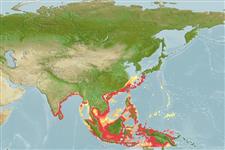Common names from other countries
Issue
Genus Eschmeyer, pers. comm.
Environment: milieu / climate zone / depth range / distribution range
Écologie
marin; saumâtre démersal; amphidrome (Ref. 51243); profondeur 16 - 73 m (Ref. 57343). Tropical; 37°N - 11°S, 75°E - 149°E
Eastern Indian Ocean and Western Pacific: southwestern India to Papua New Guinea, north to Japan. May rarely occur in the Philippines, eastern Indonesia, and Papua New Guinea (Ref. 57343). Not in Red Sea (Ref. 84159).
Taille / Poids / Âge
Maturity: Lm ? range ? - ? cm
Max length : 30.0 cm TL mâle / non sexé; (Ref. 30573); common length : 20.0 cm TL mâle / non sexé; (Ref. 30573)
Épines dorsales (Total) : 9; Rayons mous dorsaux (Total) : 12 - 13; Épines anales: 3; Rayons mous anaux: 11 - 13; Vertèbres: 24. With 6 pectoral filaments; uppermost not reaching posterior tip of pectoral fin. Pectoral fin, rays moderate, 19-25% of SL; all rays branched except uppermost 1 or 2. Second dorsal spine short, 5-8% of SL. Atrophied swim bladder, like a string. A large black spot anteriorly on lateral line (Ref. 40958, 41110). No upper lip; lower lip well-developed except at symphysis. Operculum broadly rounded; preoperculum coarsely serrated. Color is golden-olive above ,silvery below. A large oval blotch is at the start of the lateral line (Ref. 561).
A marine species found on sandy and muddy bottoms of the continental shelf (Ref. 4340, 11230, 57343). Frequently enters estuaries (Ref. 9685, 11230). Feeds mainly on small crustaceans (especially shrimps), fishes and benthic organisms; also on sponges and fish scales (Ref. 9685). The progression in this hermaphrodite is protandrous, changing from a juvenile to a hermaphrodite, then a female (Ref. 9685).
Life cycle and mating behavior
Maturities | Reproduction | Spawnings | Egg(s) | Fecundities | Larves
Motomura, H., 2004. Threadfins of the world (Family Polynemidae). An annotated and illustrated catalogue of polynemid species known to date. FAO Spec. Cat. Fish. Purp. Rome: FAO. 3:117 p. (Ref. 57343)
Statut dans la liste rouge de l'IUCN (Ref. 130435)
CITES (Ref. 128078)
Not Evaluated
Menace pour l'homme
Harmless
Utilisations par l'homme
Pêcheries: commercial; pêche sportive: oui
Outils
Articles particuliers
Télécharger en XML
Sources Internet
Estimates based on models
Preferred temperature (Ref.
115969): 23.5 - 28.4, mean 27.7 (based on 227 cells).
Phylogenetic diversity index (Ref.
82804): PD
50 = 0.5000 [Uniqueness, from 0.5 = low to 2.0 = high].
Bayesian length-weight: a=0.01479 (0.00929 - 0.02354), b=3.04 (2.91 - 3.17), in cm Total Length, based on LWR estimates for this species & (Sub)family-body (Ref.
93245).
Niveau trophique (Ref.
69278): 3.8 ±0.57 se; based on food items.
Résilience (Ref.
120179): Milieu, temps minimum de doublement de population : 1,4 à 4,4 années (Preliminary K or Fecundity.).
Fishing Vulnerability (Ref.
59153): Low to moderate vulnerability (31 of 100).
